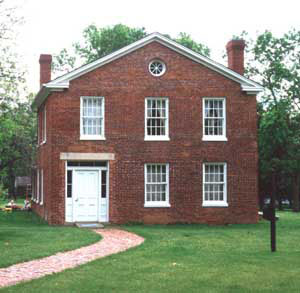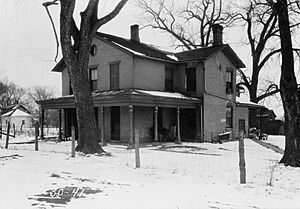Plum Grove Historic House facts for kids
Quick facts for kids |
|
|
Plum Grove
|
|

Plum Grove, Iowa City, 1996
|
|
| Location | 1030 Carroll St. Iowa City, Iowa |
|---|---|
| Built | 1844 |
| Architectural style | Greek Revival |
| NRHP reference No. | 73000731 |
| Added to NRHP | May 07, 1973 |
Plum Grove is a special historic house located in Iowa City, United States. It was the retirement home of Gov. Robert Lucas. He was the first governor of the Iowa Territory. This house was also the childhood home of the author Eleanor Hoyt Brainerd.
Contents
The Story of Plum Grove
Who Lived at Plum Grove?
The house was built in 1844. Robert Lucas lived there with his wife, Friendly, and their family. Governor Lucas passed away at Plum Grove in 1853. His family moved out of the house by 1866.
Later, the Hoyt family owned the house. Eleanor Hoyt Brainerd, a well-known author, was born there in 1868. After the Hoyts, other families lived in the house. In 1943, the state of Iowa bought Plum Grove. They fixed it up to honor Governor Lucas.
Visiting Plum Grove Today
Today, the State Historical Society of Iowa owns Plum Grove. The Johnson County Historical Society helps take care of it. You can visit the house for tours.
- From Memorial Day through Labor Day, it is open Wednesday through Sunday.
- The hours are 1 p.m. to 5 p.m.
- After Labor Day until October 31, it is open on Saturdays and Sundays.
- The hours are 1 p.m. to 5 p.m.
- You can also arrange group visits by appointment.
Discoveries at Plum Grove
What is Archaeology?
Archaeology is the study of human history and prehistory. It involves digging up old sites and studying the things people left behind. Archaeologists learn about how people lived long ago.
Digging Up History at Plum Grove
Since 1974, archaeologists have studied the grounds around Plum Grove. They have learned a lot about what life was like on the Iowa frontier. Their work shows how farming changed from 1844 until 1943. Dr. Thomas Charlton from the University of Iowa led much of this research.
Archaeologists have found many interesting things. They uncovered parts of old house additions and other small buildings. They also found a large trench filled with animal bones. These bones show what kinds of animals people ate.




